Jonathan Romney on Post Tenebras Lux: Visions of sex, the Devil – and rugby
This surreal narrative from Carlos Reygadas seems to weave in various autobiographical details, but where does the demon with a toolbox fit in?

It's such a rare, refreshing thing when film directors turn up with a genuine vision that it can almost seem superfluous to ask exactly what they have a vision of. To be honest, I have only the vaguest sense of what's on Mexican director Carlos Reygadas's mind in Post Tenebras Lux – except that his film variously addresses family life, forestry, social divisions in contemporary Mexico, swinger sex, the Devil, and rugby union as played in the public schools of Derbyshire.
What a singular thing this enigmatic, fragmented film is. Reygadas has always been interested in the natural world and humanity's place in it: his previous feature, Silent Light, began with a hypnotic extended shot of the night sky. But he can also be confrontational: Battle in Heaven featured shock bloodshed alongside sex that was both extreme and ecstatic. Now the various registers of Reygadas's cinema come together in this fourth feature, his most overtly experimental yet – a jigsaw of seemingly mismatched pieces.
The ostensible story involves a well-heeled couple, Juan (Adolfo Jimenez Castro) and Natalia (Nathalia Acevedo), and their two children, toddlers when we first meet them (played at their youngest by the director's offspring, Rut and Eleazar Reygadas). They have a lovely home in a lush rural landscape, but all is not well. Juan has a filthy temper which he vents on one of the family dogs. He also has a porn addiction, as we learn when he visits an AA meeting with "El Siete" (Willebaldo Torres), a local man who works for him. Nor is home the haven it seems. Early on, while the family sleeps, a door opens, admitting an eerie pink-red glow – and a luminous CGI devil carrying a toolbox steps in and prowls silently around. This isn't the weirdest thing in the film by any means. That comes later, in an abrupt act of utterly surreal (and physically impossible) violence.
But Reygadas doesn't lay on strangeness with a trowel, and often finds it in the most everyday images. The film begins with little Rut wandering around a field at twilight, lightning flashing in the sky. She's apparently alone, oblivious to any danger and delighting in the cows wandering about. But there are dogs wheeling around too, and as night draws in, this very elemental scene increasingly plays on our anxiety for the defenceless child. There's also the fact that Alexis Zabe (the cameraman) uses a lens with a strange, blurring effect round its edges – at once heightening the immediacy of the image and distancing us from it.
But that's just the start. Throughout, stand-alone fragments stubbornly refuse to fit the picture. A man talks about planning to murder his sister. Two old-timers play chess and get stoned. Some scenes show the family, seemingly much later in their lives – or in a parallel version of their lives, given the contradictory chronology.
Then there's the sex scene, not quite graphic but certainly no-holds-barred. Juan and Natalia wander through a swingers' club, seemingly in Paris, with its steam rooms comically named after Hegel and Duchamp (presumably there's also a Houellebecq room, where you're allowed to smoke). As naked customers of various degrees of fleshiness look on, Natalia has sex with a male stranger while she's gently cradled by an older woman. In cinema it's customary to assume that sex-club scenes emphasise brutishness and anonymity, but Reygadas's is different. Natalia clearly derives pleasure from her adventure, and the scene evokes a tender and, for once, genuinely erotic moment of human contact. One caveat, though: what to make of the fact that the club is suffused with the same pink glow emitted earlier by the visiting devil?
And what of the stray scenes of a rugby match at an English public school? We know that the Derbyshire school in question was one that Reygadas himself attended as a boy, and he has said that there are autobiographical elements in Post Tenebras Lux – but I'm not sure where that gets us. How does the rugby fit in? By not fitting in, perhaps; it seems a deliberately incongruous element, just as Robert Rauschenberg used to incorporate cartoon images into his paintings.
The title means "After Darkness, Light" – but I can't really say that the film's obscurity was followed for me by any flash of understanding. That said, on a second viewing the central line of narrative seemed more transparent than it had at first. This is a mysterious work rather than a mystifying one. In Cannes last year, some railed at Post Tenebras Lux winning Reygadas the best director prize. But if Terrence Malick can be lauded for the religiose bombast of The Tree of Life and the vaporous To the Wonder, cinephiles should give a chance to something equally exalted yet considerably earthier, in its no-nonsense microbudget way. Suffice to say that, whatever he's up to here, Carlos Reygadas remains as defiantly, joyously out there as any film-maker working today.
Subscribe to Independent Premium to bookmark this article
Want to bookmark your favourite articles and stories to read or reference later? Start your Independent Premium subscription today.

Join our commenting forum
Join thought-provoking conversations, follow other Independent readers and see their replies